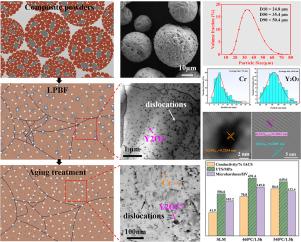Yttria enhanced CuCr composites fabricated by laser powder bed fusion: Microstructure, properties and strengthening mechanisms
IF 14.3
1区 材料科学
Q1 MATERIALS SCIENCE, MULTIDISCIPLINARY
引用次数: 0
Abstract
Complex and harsh service environments impose higher demands on comprehensive performance of high-strength and high-conductivity Cu-Cr series alloys. This work introduces Y2O3 nanoparticles into CuCr alloy by the laser powder bed fusion (LPBF) process, aiming to further enhance its mechanical properties while preserving its electrical conductivity. The spherical Cu-0.7Cr-2Y2O3 composite powders with excellent flowability are prepared using the spray drying and pre-sintering methods. Different laser powers and scanning speeds are utilized to optimize the LPBF forming processes. The CuCr-Y2O3 composites with a high relative density of 99.4% are successfully fabricated at a laser power of 250 W and a scanning speed of 400 mm/s. The effect of aging treatments on the evolution of the microstructure and properties of as-printed CuCr-Y2O3 composites is systematically analyzed. In the LPBF samples, Y2O3 particles with an average size of 46.7 nm are homogeneously dispersed in the copper matrix, and few Cr nano-precipitates are observed. Following aging treatment, the morphology and size of Y2O3 particles remain consistent, while a greater density of Cr phases, with an average size of 7.3 nm, precipitate and exhibit a coherent interface relationship with the matrix. Aging treatment conducted at 460°C for 1.5 h results in a peak tensile strength of 691.6 MPa, elongation of 21.5%, electrical conductivity reaching 79.6% IACS, microhardness values of 152.7 HV at room temperature and 112.2 HV at 500°C. Moreover, the conductivity mechanisms and strengthening mechanisms are discussed. The full aging of solid solution Cr elements and minimal negative effects of Y2O3 particles on electron scattering, contribute to the excellent electrical conductivity. The superior mechanical properties at both room and elevated temperatures are primarily attributed to the synergistic strengthening effect provided by the shearing mechanism of fine Cr precipitates and the Orowan mechanism of Y2O3 particles and lager Cr precipitates.

激光粉末床熔合制备氧化钇增强CuCr复合材料:显微组织、性能及强化机理
复杂恶劣的使用环境对高强度、高导电性Cu-Cr系合金的综合性能提出了更高的要求。本研究通过激光粉末床熔合(LPBF)工艺将Y2O3纳米颗粒引入CuCr合金,旨在进一步提高CuCr合金的机械性能,同时保持其导电性。采用喷雾干燥法和预烧结法制备了流动性良好的球形Cu-0.7Cr-2Y2O3复合粉体。利用不同的激光功率和扫描速度对LPBF成形工艺进行了优化。在激光功率为250 W、扫描速度为400 mm/s的条件下,成功制备了相对密度高达99.4%的CuCr-Y2O3复合材料。系统分析了时效处理对CuCr-Y2O3打印复合材料组织和性能演变的影响。在LPBF样品中,平均尺寸为46.7 nm的Y2O3颗粒均匀分布在铜基体中,少量Cr纳米析出。时效处理后,Y2O3颗粒的形貌和尺寸保持一致,而Cr相密度较大,平均尺寸为7.3 nm,析出并与基体形成共格界面关系。在460℃时效1.5 h,峰值抗拉强度为691.6 MPa,伸长率为21.5%,电导率达到79.6% IACS,室温显微硬度为152.7 HV, 500℃显微硬度为112.2 HV。并讨论了导电机理和强化机理。固溶体Cr元素的充分时效和Y2O3颗粒对电子散射的负面影响最小,有助于优异的导电性。室温和高温下优异的力学性能主要是由于细小Cr析出物的剪切机制和Y2O3颗粒与较大Cr析出物的Orowan机制的协同强化作用。
本文章由计算机程序翻译,如有差异,请以英文原文为准。
求助全文
约1分钟内获得全文
求助全文
来源期刊

Journal of Materials Science & Technology
工程技术-材料科学:综合
CiteScore
20.00
自引率
11.00%
发文量
995
审稿时长
13 days
期刊介绍:
Journal of Materials Science & Technology strives to promote global collaboration in the field of materials science and technology. It primarily publishes original research papers, invited review articles, letters, research notes, and summaries of scientific achievements. The journal covers a wide range of materials science and technology topics, including metallic materials, inorganic nonmetallic materials, and composite materials.
 求助内容:
求助内容: 应助结果提醒方式:
应助结果提醒方式:


